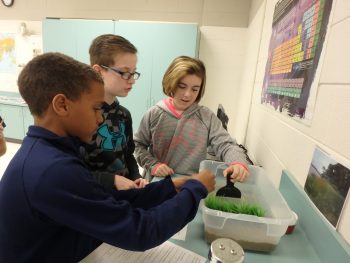Native plants, costal habitats, juvenile animals and shoreline erosion — those were all topics of four lessons led by the two AmeriCorps members in the North Carolina Coastal Federation’s Wanchese office in late April.
On April 20 and 21, Madison Douthitt, AmeriCorps member who started working at the federation in March, visited First Flight Elementary School’s third grade classes to talk about plant parts and native plants. She talked about how plants native to the Outer Banks have adapted to the sometimes harsh environment — plants there have to stand up to dry conditions, wind and salt.
“Students were given a picture and description of a native plant and they determined in which coastal habitat their plant lived,” Douthitt said. “After matching their plant to a habitat students shared with the class the different adaptations the plant had which allowed it to be successful on our barrier islands.”

Students simulate a living shoreline during a lesson about erosion.
The next week, Douthitt and Erica Connery, who is also an AmeriCorps member with the federation’s Wanchese office, spent time at Manteo Elementary School for second-grade and fourth-grade lessons.
Connery led life cycle lessons with the second-grade classes. Students matched “baby” animals to their adult counterparts and learned that some juvenile animals don’t look much like their parents.
Douthitt led a fourth-grade lesson on erosion. The students used bins with water, sand and other materials to simulate a grassy shoreline, a living shoreline and a bulkhead. This activity is designed to show students the effectiveness of living shorelines for erosion control.
“The class came up with hypotheses on which shoreline would have the most erosion,” Douthitt said. “They then tested their hypotheses by creating waves in the bins and measuring the distance the shoreline moved.”
For more information about the federation’s education programs, visit nccoast.org/educate.
